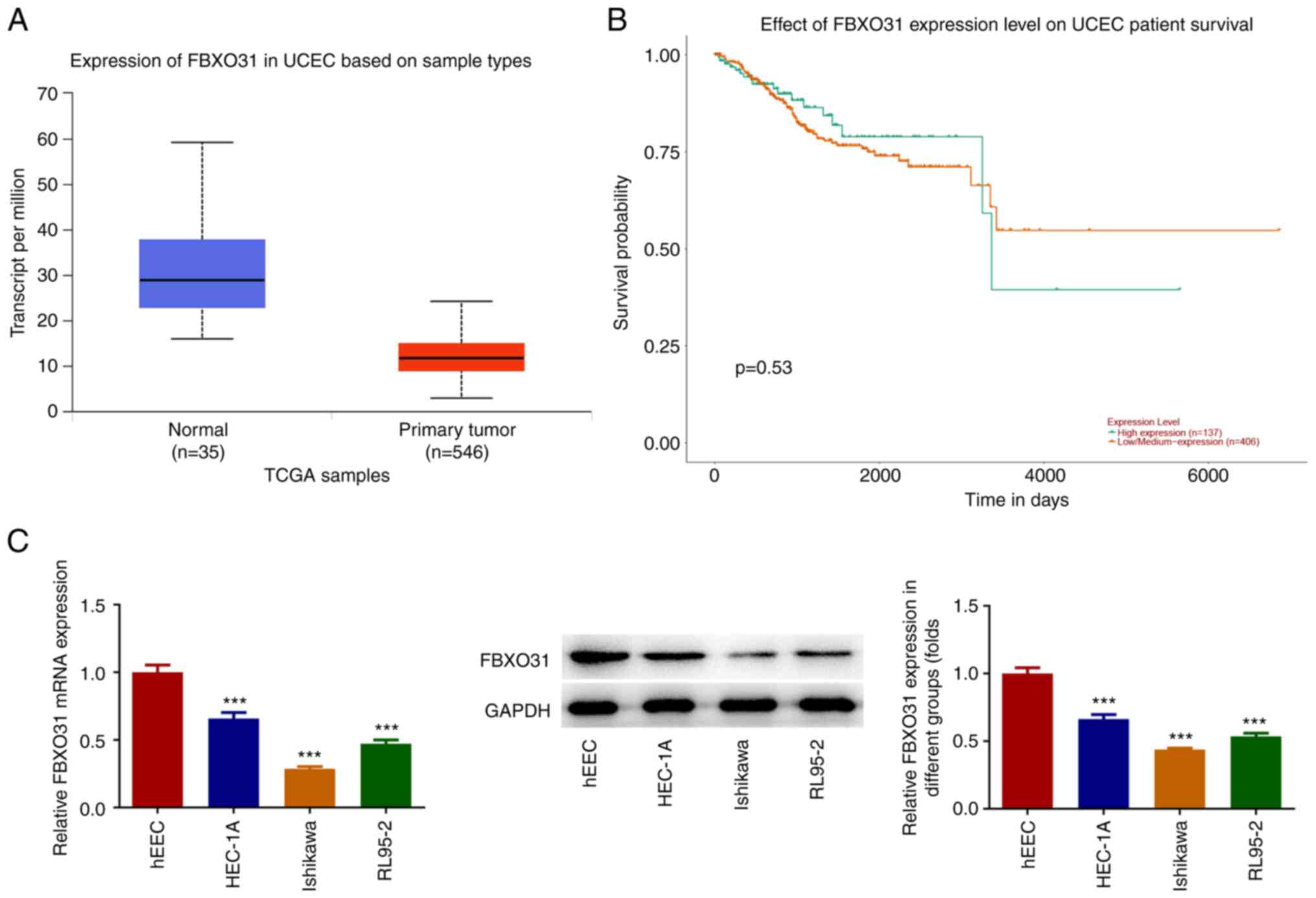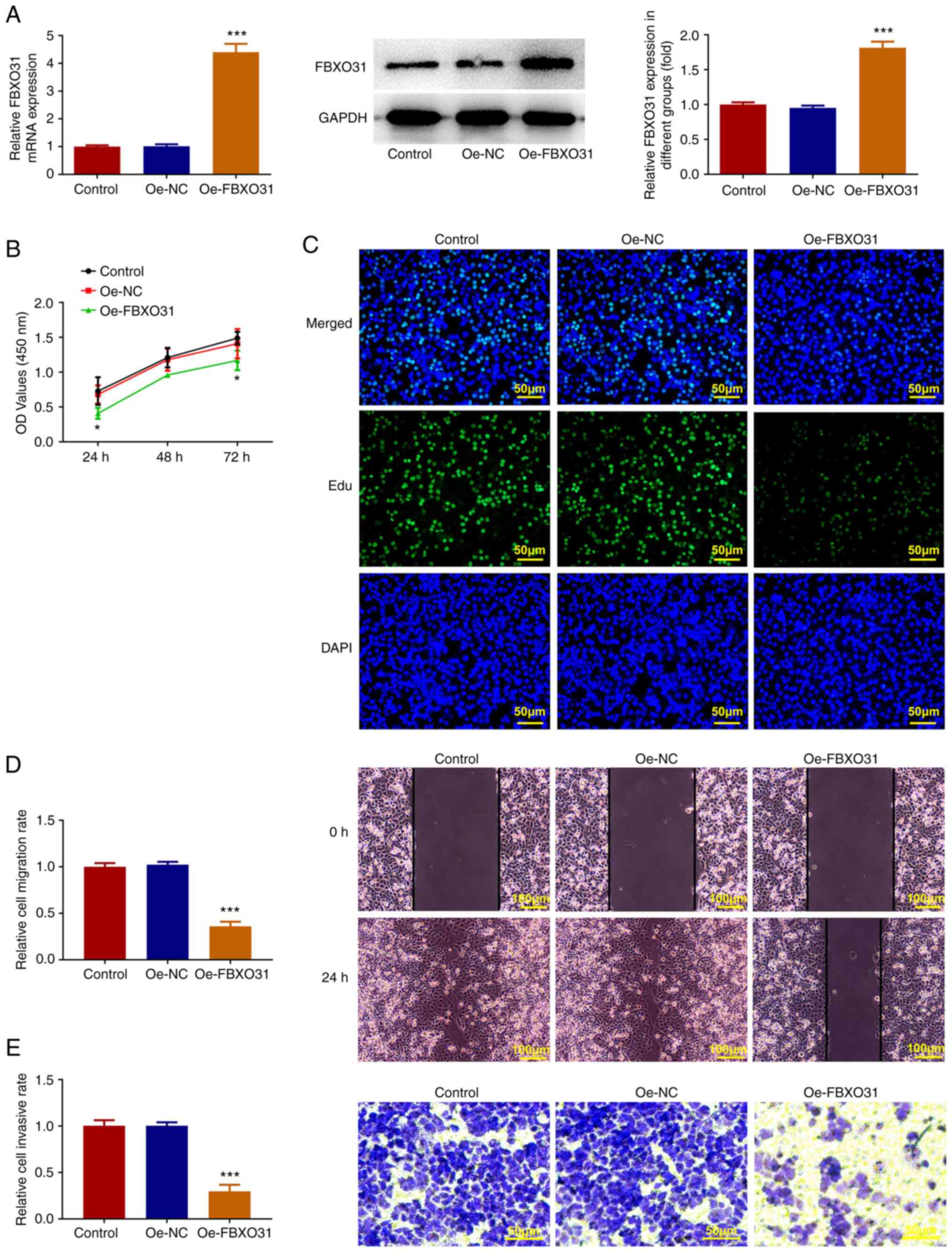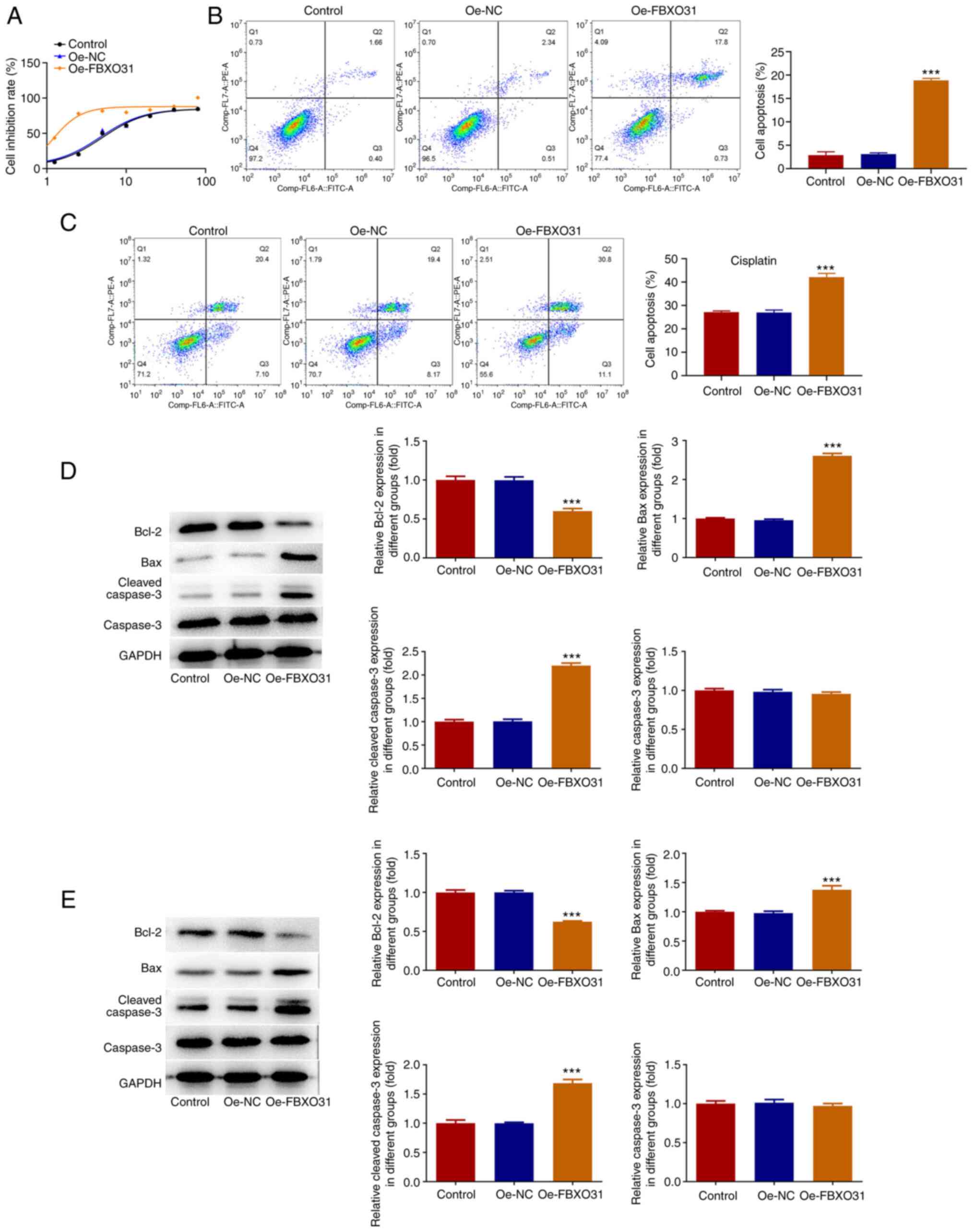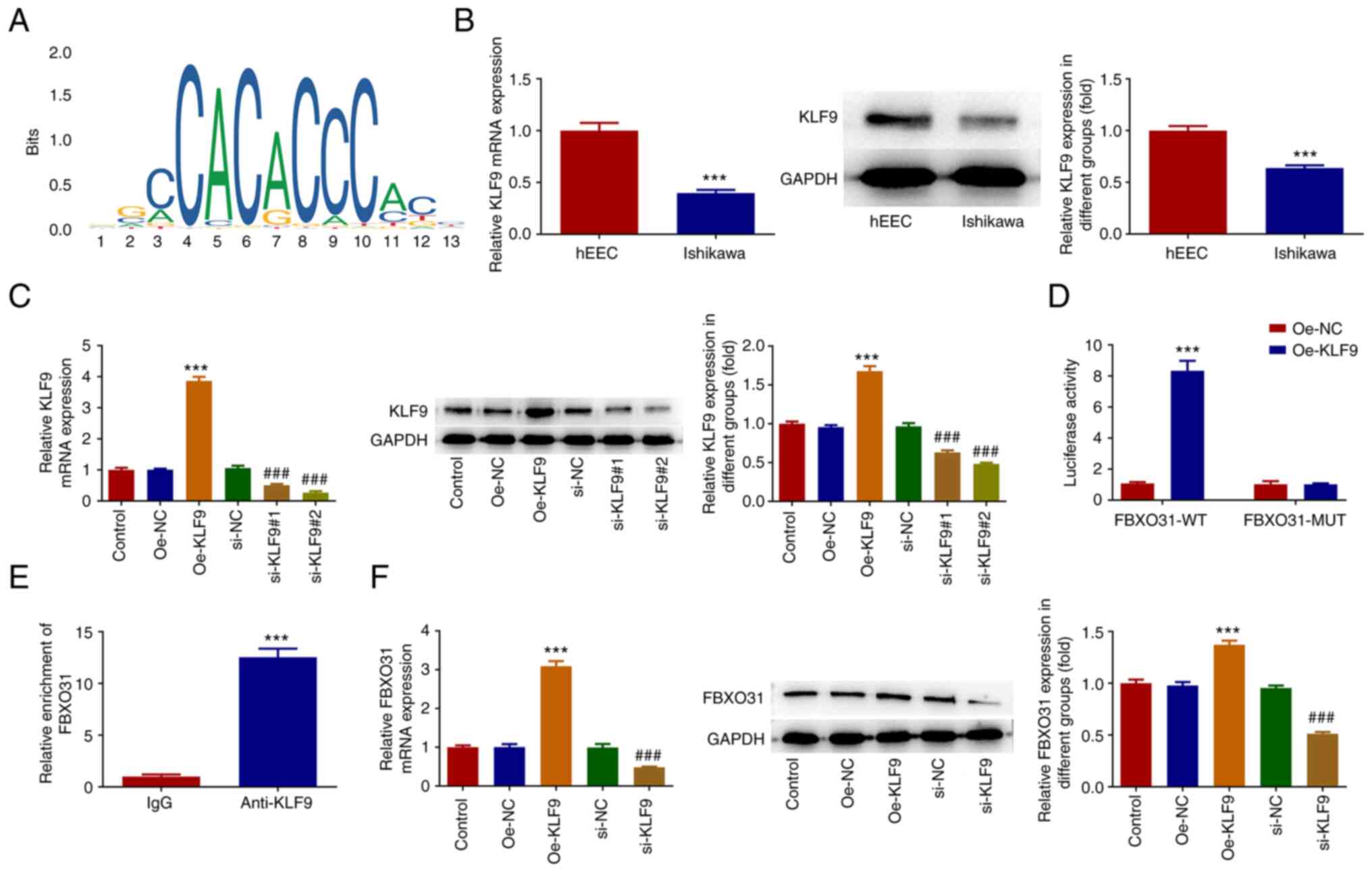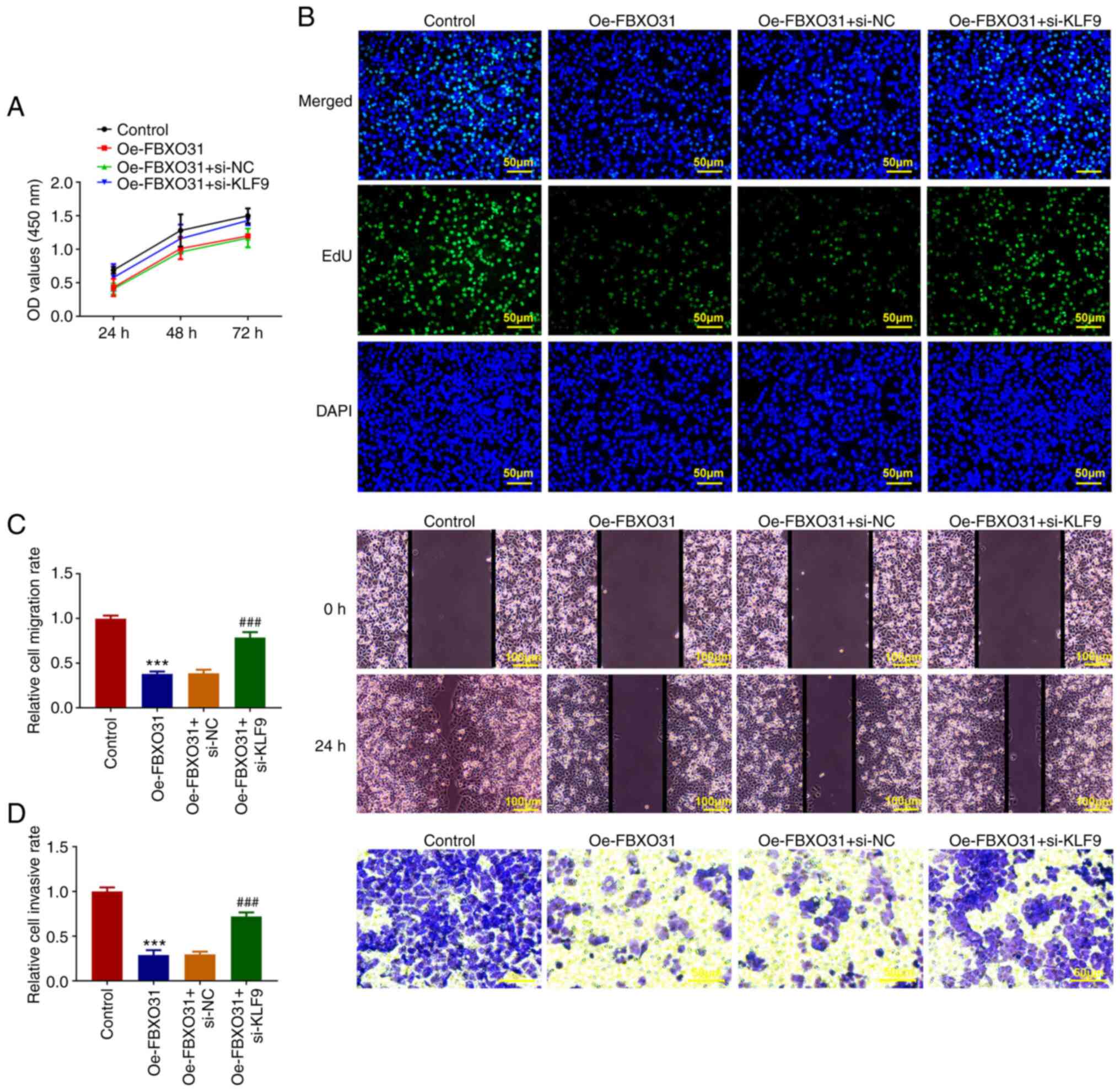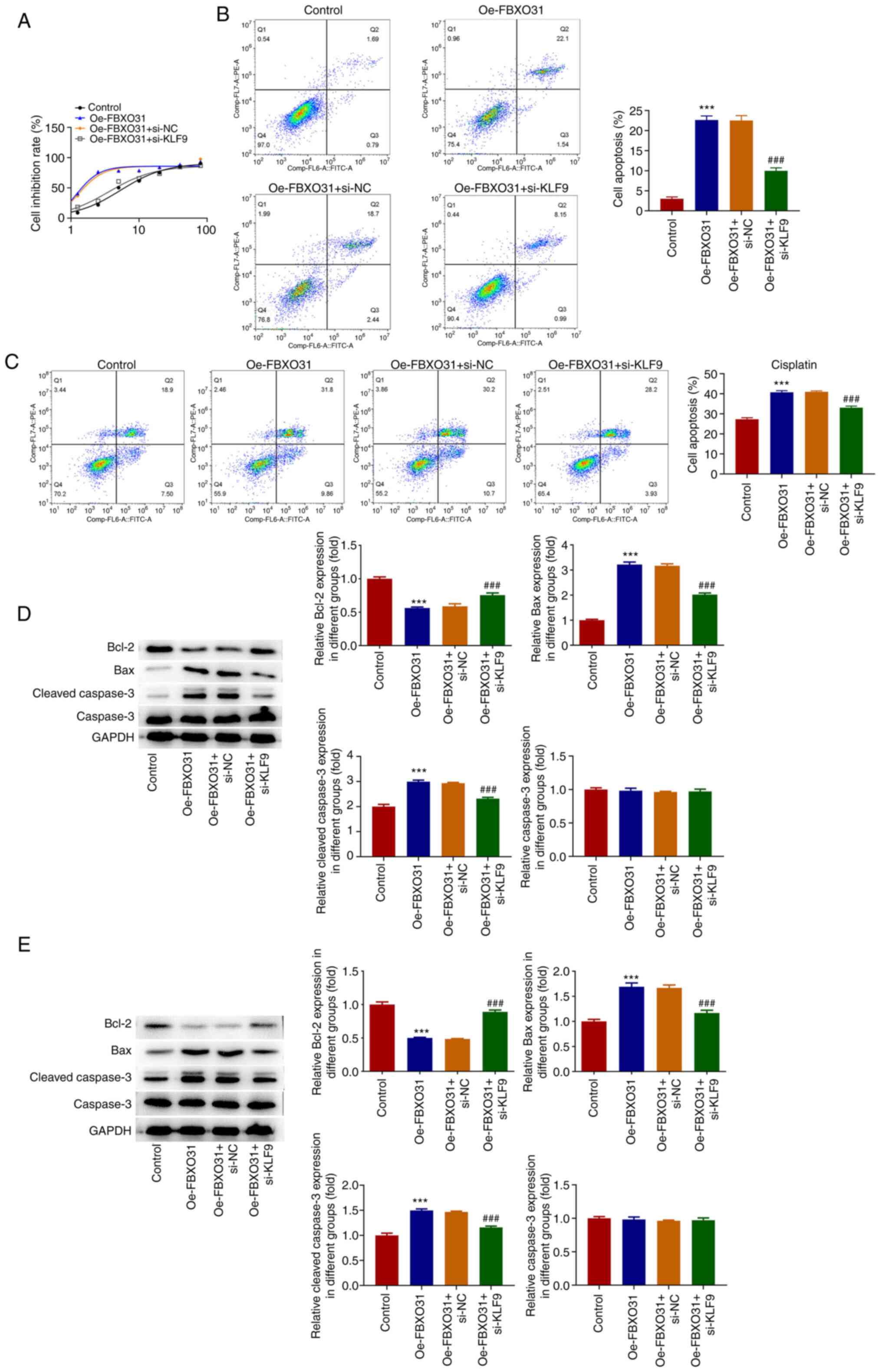KLF9‑regulated FBXO31 inhibits the progression of endometrial cancer and enhances the sensitivity of endometrial cancer cells to cisplatin
- Authors:
- Published online on: December 5, 2023 https://doi.org/10.3892/etm.2023.12342
- Article Number: 54
-
Copyright: © Yang et al. This is an open access article distributed under the terms of Creative Commons Attribution License.
Abstract
Introduction
Endometrial cancer (EC) is the second most common gynecological type of cancer, with 417,367 new cases and 97,370 new deaths worldwide in 2021. The incidence of EC is increasing every year (1). Currently, adjuvant chemotherapy, including cisplatin (DDP), is used in clinical practice to improve the therapeutic effect and prognosis of EC. However, patients who undergo long-term chemotherapy can often develop drug resistance, thus limiting its effect (2,3). Oncological nursing has also played a significant role in the prognosis of human malignancies, including EC (4,5). Therefore, the identification of novel mechanisms and tumor active markers to reverse the resistance of tumor cells to chemotherapeutic drugs and improve the sensitivity of chemotherapy have become the main means to improve the prognosis of patients with cancer.
F-box only protein 31 (FBXO31), which belongs to the FBXO family, serves a significant role in DNA damage response and cell cycle regulation, and is involved in the development and occurrence of several types of tumors (6). A previous study showed that FBXO31 could act as a tumor suppressor gene in cholangiocarcinoma, while it could sensitize cancer stem cell-like cells to DDP via promoting ferroptosis and proteasome-mediated degradation of glutathione peroxidase 4(7). In addition, FBXO31 inhibited lipogenesis and tumor progression in glioma by promoting the ubiquitination and degradation of CD147(8). Another study also suggested that the c-Myc oncogene could impair the inhibitory effect of FBXO31 on tumor development, thus promoting the progression of ovarian cancer (9). The aforementioned findings indicated that FBXO31 was downregulated in different types of cancer and it was, therefore, considered as a candidate tumor suppressor gene. The UALCAN database (https://ualcan.path.uab.edu/analysis.html) was applied to predict the expression levels of FBXO31 in patients with EC and the high expression of FBXO31in EC and the association between FBXO31 expression and EC prognosis were found. However, its effects on EC and DDP resistance remain to be elucidated.
The JASPAR database (https://jaspar.genereg.net/) was used to predict the binding capacity of Krüppel-like factor 9 (KLF9) transcription factors on FBXO31 promoter. The KLF family is a significant group of transcription factors in eukaryotes (10). Their carboxyl terminus contains three highly conserved zinc finger domains of Cys2/His2, which bind to promoters or enhancers to regulate the expression of their corresponding target genes, thus exerting several biological functions (11). KLF9 can be used as a prognostic marker of EC (12,13). A previous study has shown that EC cell proliferation and invasion can be inhibited by upregulating KLF9 in EC (14). However, the regulatory relationship between FBXO31 and KLF9 in EC has not so far been reported.
Therefore, the current study aimed to investigate the role and regulatory mechanism of FBXO31 and its effect on DDP resistance in EC.
Materials and methods
Databases
The UALCAN database was applied to predict the expression levels of FBXO31 in patients with EC and the association between FBXO31 expression and EC prognosis (15). Additionally, the JASPAR database was used to predict the binding capacity of KLF9 transcription factors on FBXO31 promoter (16).
Cell culture
The immortalized human endometrial epithelial cells hEEC (cat. no. MZ-3223; Ningbo Mingzhou Biotechnology Co., Ltd.) and the EC cell lines HEC-1A (cat. no. BNCC338711; BeNa Culture Collection), RL95-2 (cat. no. BNCC356242; BeNa Culture Collection) and Ishikawa (cat. no. BNCC342468; BeNa Culture Collection) were cultured in DMEM supplemented with 10% fetal bovine serum (FBS; Thermo Fisher Scientific, Inc.) at 37˚C in an incubator with 5% CO2.
Reverse transcription-quantitative PCR (RT-qPCR)
RT-qPCR was used to detect mRNA expression in cells. Total RNA was extracted from 1x104 cells using a TRIzol reagent (Thermo Fisher Scientific, Inc.) according to the manufacturer's protocols. The first-strand cDNA was synthesized using random primers according to the manufacturer's protocols. The mRNA expression levels were determined by RT-qPCR using the Bio-Rad CFX96TM Real-Time PCR System (Bio-Rad Laboratories, Inc.) with the SYBR Green Kit (Takara Bio, Inc.), according to the manufacturer's instructions. The thermocycling conditions used were: 5 min at 95˚C, followed by 40 cycles at 95˚C for 15 sec and at 60˚C for 34 sec. GAPDH served as an internal control gene for normalization and the expression levels were calculated using the 2-ΔΔCq method (17). The PCR primers were as follows: FBXO31 forward: 5'-ACAGCGTTCAGAAGATGGCT-3', reverse: 5'-GGTGGATCCTGAACAGAGGC-3'; KLF9 forward: 5'-TGGGAGCAGTCCATGGGATA-3', reverse: 5'-AAAGGCAGCGTGCAGAGTAT-3'; GAPDH forward: 5'-ACAGCGTTCAGAAGATGGCT-3', reverse: 5'-GGTGGATCCTGAACAGAGGC-3'. Each experiment was repeated three times.
Western blot analysis
Ishikawa cells were harvested and lysed with RIPA buffer (Thermo Fisher Scientific, Inc.). Protein concentration was measured using a bicinchoninic assay (Beyotime Institute of Biotechnology). The 30 µg protein/lane was separated on 12% gels using SDS-PAGE and were then transferred onto a PVDF membrane (MilliporeSigma). Following blocking with 5% non-fat milk for 1 h at room temperature, the membrane was incubated with primary antibodies FBXO31 (1:1,000; cat. no. ab86137; Abcam), Bcl-2 (1:1,000; cat. no. ab182858; Abcam), Bax (1:1,000; cat. no. ab32503; Abcam), cleaved caspase3 (1:1,000; cat. no. ab32042; Abcam), caspase3 (1:1,000; cat. no. ab32351; Abcam), KLF9 (1:1,000; cat. no. ab227920; Abcam), GAPDH (1:1,000; cat. no. ab9485; Abcam) at 4˚C overnight. The next day, the membranes were incubated with the corresponding anti-rabbit IgG conjugated to HRP (1:5,000; cat. no. sc-2357; Santa Cruz Biotechnology, Inc.) for 2 h at room temperature. Finally, the protein bands were visualized using the Enhanced ECL Chemiluminescent Substrate Kit (Shanghai Yeasen Biotechnology Co., Ltd.) and the signal intensity was measured with ImageJ software (version 1.48; National Institutes of Health).
Cell transfection
For transfection, cells were cultured into plates for 24 h and were then transfected with FBXO31 overexpression (Oe-FBXO31) plasmid or the corresponding negative control vector (Oe-NC) and small interfering (si)-RNA clones targeting KLF9 (si-KLF9#1 and si-KLF9#2) or the corresponding si-NC (Shanghai GenePharma Co., Ltd.) using Lipofectamine® 2000 (Invitrogen; Thermo Fisher Scientific, Inc.) at 37˚C for an additional 48 h, according to the manufacturer's instructions. After transfection for 48 h, RT-qPCR and western blotting were used to detect the transfection effect as aforementioned. The transfected cells were treated with DDP or control PBS medium, incubated for 24 h and harvested for further analysis. The sequences were as follows: si-KLF9#1 sense, 5'-UGUAAUGGGCUUUGAGAUGGG-3' and antisense, 5'-CAUCUCAAAGCCCAUUACAGA-3'; si-KLF9#2 sense, 5'-UUUUCACGCGUCUGUUUCCUG-3' and antisense, 5'-GGAAACAGACGCGUGAAAACU-3' and si-NC sense, 5'-UUCUCCGAACGUGUCACGUTT-3' and antisense, 5'-ACGUGACACGUUCGGAGAATT-3'.
Cell Counting Kit 8 (CCK-8) and EdU assays
Cell viability was assessed using a commercial CCK-8 assay kit (Nanjing Jiancheng Bioengineering Institute). The absorbance at wavelength of 450 nm was measured using a microplate reader. In addition, EdU assay was carried out to evaluate the proliferation ability of EC cells using the EdU Cell Proliferation Kit (YuhengBio). EdU-positive cells were counted and images were captured under a fluorescent microscope (Leica Microsystems GmbH).
Wound healing assay
Wound healing assay was used to detect the cell migration. Ishikawa cells were plated into a 6-well plate and cell transfection techniques were used to overexpress FBXO31 or interfere with KLF9 expression. Subsequently, a linear scratch was gently created using a sterile 10-µl plastic tip. The medium was removed from the plate and the plate was then washed using PBS to remove non-attached cells. The attached cells were cultured in serum-free DMEM. The migrated cells were observed under a light microscope at magnification of x100 and the wound width was measured at 0 and 24 h. The recovery rate of the wound was calculated using the following equation: [(width at 0 h-width at 24 h)/width at 0 h] x100%.
Transwell assay
Transwell assay was used to detect the cell invasion. For Transwell assays, Ishikawa cells were seeded into 24-well Transwell cell culture chambers with filters of 8-µm pores. Transwell apical chambers precoated with 1% Matrigel basement membrane gel (Corning, Inc.) at 37˚C for 30 min were used for cell invasion. The upper chambers pre-coated or not with Matrigel (40 µl/well) were supplemented with Ishikawa cells in DMEM. The lower chamber was filled-up with DMEM containing 10% FBS. The cells were routinely cultured for 24 h. Subsequently, cells on the surface of the membranes were collected and stained with 0.5% crystal violet for 15 min at room temperature. Finally, images of the migrated and invaded cells in five randomly selected fields were captured under a light microscope at magnification of x200 and the cell migration and invasion rates were determined using ImageJ software (version 1.48; National Institutes of Health).
Flow cytometric analysis
Flow cytometric analysis was used to detect apoptosis. After treatment with the indicated compounds, Ishikawa cells were seeded into 6-well plates at a density of 106 cells/well and incubated for an additional 24 h. Subsequently, cells were stained with annexin V-FITC/PI (5 µl/5 µl) at room temperature in the dark for 15 min using an apoptosis detection kit, according to the manufacturer's instructions. Cell suspensions were examined by flow cytometry (Gallios; Beckman Coulter, Inc.). The flow cytometry data were analyzed with CellQuest Pro software (version 3.3; BD Biosciences). Apoptosis rate was calculated as the sum of the early apoptosis rate (the lower right quadrant) and the late apoptosis rate (the upper right quadrant).
Luciferase reporter assay
Luciferase reporter assay was used to detect promoter activity of FBXO31. Wild-type (WT) or mutant (MUT) FBXO31 promoter were cloned into the pGL3 Basic vector (Promega Corporation). Following overexpressed FBXO31 or interfere with KLF9 expression, Ishikawa cells were seeded into 12-well plates and co-transfected with plasmids encompassing the promoter region of FBXO31, the pRL-SV40 Renilla luciferase reporter vector (Promega Corporation) and KLF9 overexpression plasmid or control vector using Lipofectamine® 2000 (Invitrogen; Thermo Fisher Scientific, Inc.). The luciferase activity was measured at 48 h after transfection using the Dual Luciferase Assay System (Promega Corporation) and was normalized to Renilla luciferase activity.
Chromatin immunoprecipitation (ChIP) assay
ChIP assay was used to verify the relationship between FBXO31 and KLF9. Following overexpressed FBXO31 or interfere with KLF9 expression, a total of 4x106 Ishikawa cells were treated with 3.7% formaldehyde for 10 min at 25˚C to crosslink DNA with proteins followed by centrifugation at 300 x g for 3 min at 25˚C, and washed in pre-cooled PBS for 10 min at 25˚C. Subsequently, the cells were lysed in 300 µl SDS lysis buffer [1% SDS, 10 mM EDTA and 50 mM Tris-HCl (pH 8.0)] and the cell lysates were sonicated to shear DNA to fragments of 200 to 500 bp in length. The DNA fragments from the 100 µl cell lysates were then immunoprecipitated overnight at 4˚C with an antibody against KLF9 (1:300). IgG (1:100) served as control antibody. Then, all samples were supplemented with protein A/G beads followed by incubation at 4˚C for 2 h. Beads were then washed with 1 ml each of low salt immune complex wash buffer, high salt immune complex wash buffer, LiCl immune complex wash buffer and TE buffer (all Merck KGaA) at 4˚C. The bound immunocomplex was eluted by adding 300 µl of fresh elution buffer [10 mM Tris; 1 mM EDTA (pH 8.0)]. To reverse cross-linking, the samples were treated with proteinase K. Subsequently, DNA was eluted and purified using the phenol/chloroform/isoamyl alcohol extraction method. Finally, the recruitment of KLF9 on FBXO31 promoter was assessed by RT-qPCR using the SYBR Green Kit (Takara Bio, Inc.) according to the manufacturer's instructions. Input groups served as a positive control and IgG groups served as a negative control. The thermocycling conditions used were: 5 min at 95˚C, followed by 40 cycles at 95˚C for 15 sec and at 60˚C for 34 sec. The PCR products were resolved by agarose gel electrophoresis on 2% gel with ethidium bromide and semi-quantitatively analyzed by ImageJ software (version 1.38).
Statistical analysis
All data are expressed as the mean ± SD. All statistical analyses and graph generation were performed using GraphPad 8.0 statistical software (Dotmatics). The results were compared using one-way ANOVA followed by Tukey's post-hoc test. P<0.05 was considered to indicate a statistically significant difference.
Results
FBXO31 is downregulated in EC
Bioinformatics analysis using the UALCAN database showed that FBXO31 was downregulated in EC tissues (Fig. 1A). In addition, FBXO31 downregulation in EC was associated with poor prognosis (Fig. 1B). Furthermore, the expression levels of FBXO31 were detected in EC cell lines by RT-qPCR and western blot analysis. The results demonstrated that compared with control cells, the expression levels of FBXO31 were significantly decreased in the EC cell lines (Fig. 1C). Among them, Ishikawa cells displayed the most significantly reduced FBXO31 levels and, therefore, these cells were selected for the follow-up experiments.
FBXO31 overexpression inhibits the malignant progression of EC cells
An Oe-FBXO31 plasmid was constructed and cells were then divided into the control, Oe-NC group and Oe-FBXO31 groups. The transfection efficacy was verified by RT-qPCR and western blot analysis (Fig. 2A). Furthermore, cell viability and proliferation were assessed by CCK-8 and EdU staining assays. Cell viability was significantly decreased in the Oe-FBXO31 group compared with the Oe-NC group (Fig. 2B and C). Additionally, the invasion and migration abilities of Ishikawa cells were evaluated by wound healing and Transwell assays. The results revealed that the invasion and migration abilities of Ishikawa cells were notably attenuated following FBXO31 overexpression (Fig. 2D and E).
FBXO31 overexpression enhances the sensitivity of EC cells to DDP
CCK-8 assay was carried out to measure the half inhibitory concentration (IC50) of DDP in EC cells following FBXO31 overexpression, compared with the other groups. The IC50 of the control and Oe-FBXO31 group was 4.991 and 1.142 µg/ml, respectively, thus indicating that the IC50 of DDP was significantly decreased in the Oe-FBXO31 group compared with the Oe-NC group (Fig. 3A). This finding suggested that FBXO31 overexpression could enhance the sensitivity of EC cells to DDP. Furthermore, cell apoptosis was assessed by flow cytometric analysis after cell treatment with PBS or DDP (IC50). The results showed that following cell treatment with PBS, the apoptosis rate of cells in the Oe-FBXO31 group was significantly increased (apoptosis rate, 22%) compared with the Oe-NC group (Fig. 3B). Following treatment of cells with 1.142 µg/ml DDP, the cell apoptosis rate was notably elevated in the Oe-FBXO31 group (apoptosis rate, ~44%) compared with the Oe-NC group (Fig. 3C). Western blot analysis demonstrated that Bax and cleaved caspase 3 were markedly upregulated and Bcl2 was downregulated in PBS-treated cells in the Oe-FBXO31 group compared with the Oe-NC group (Fig. 3D). Consistently, the expression levels of Bax and cleaved caspase 3 were significantly enhanced and those of Bcl2 were markedly reduced in FBXO31 overexpressing cells treated with 1.142 µg/ml DDP compared with the Oe-NC group. However, compared with PBS the expression of apoptosis-related proteins changed more significantly following DDP intervention (Fig. 3E).
KLF9 promotes the transcription of FBXO31
The JASPAR database predicted the binding sites of the KLF9 transcription factor on FBXO31 promoter (Fig. 4A). RT-qPCR and western blot analysis showed that the expression of KLF9 was abnormally decreased in EC cells (Fig. 4B). Subsequently, EC cells were transfected with KLF9 overexpression and interference plasmids, and the transfection efficacy was detected by qPCR and western blot analysis (Fig. 4C). The si-KLF9#2 clone was selected for the follow-up experiments. The promoter activity of FBXO31 was detected by luciferase assay. Therefore, the results showed that the promoter activity in the FBXO31-wild type (WT) + Oe-KLF9 group was significantly enhanced compared with the FBXO31-WT + Oe-NC group (Fig. 4D). ChIP results also verified the binding capacity of KLF9 on FBXO31 promoter (Fig. 4E). In addition, FBXO31 was significantly upregulated in KLF9-overexpressing cells and markedly downregulated in KLF9-depleted Ishikawa cells (Fig. 4F).
KLF9-regulated FBXO31 inhibits the progression of EC and enhances the sensitivity of EC cells to DDP
Cells were divided into the control, Oe-FBXO31, Oe-FBXO31 + si-NC and Oe-FBXO31 + si-KLF9 groups. The CCK-8 and EdU staining assay results showed that compared with the Oe-FBXO31 + si-NC group, the viability and proliferation capacity of cells in the Oe-FBXO31 + si-KLF9 group were significantly increased (Fig. 5A and B). Furthermore, wound healing and Transwell assays demonstrated that cell invasion and migration were notably enhanced in the Oe-FBXO31 + si-NC group compared with the Oe-FBXO31 + si-KLF9 group (Fig. 5C and D). Subsequently, CCK-8 assays were performed to detect the IC50 of DDP in transfected EC cells. The IC50 values were 5.339 µg/ml in the control group, 1.196 µg/ml in the Oe-FBXO31 group, 1.260 µg/ml in the Oe-FBXO31 + si-NC group and 3.565 µg/ml in the Oe-FBXO31 + si-KLF9 group, thus indicating that the IC50 value of DDP in the Oe-FBXO31 + si-KLF9 group was significantly increased compared with that in the Oe-FBXO31 + si-NC group (Fig. 6A). Furthermore, flow cytometry was used to assess cell apoptosis in PBS- and DDP-treated cells. The results revealed that the cell apoptosis rate in PBS-treated cells in the Oe-FBXO31 + si-KLF9 group was significantly reduced compared with the Oe-FBXO31 + si-NC group (apoptosis rate, 10%; Fig. 6B). After DDP intervention, cell apoptosis was significantly reduced in the Oe-FBXO31 + si-KLF9 group, compared with the Oe-FBXO31 + si-NC group (apoptosis rate, 35%; Fig. 6C). Additionally, western blotting results showed that after PBS intervention, Bax and cleaved caspase 3 were markedly downregulated, while Bcl2 was upregulated in the Oe-FBXO31 + si-NC group compared with the Oe-FBXO31 + si-KLF9 group. Consistently, treatment with DDP further downregulated Bax and cleaved caspase 3, and upregulated Bcl2 in the Oe-FBXO31 + si-NC group compared with the Oe-FBXO31 + si-KLF9 group. However, compared with cells treated with PBS, the expression of apoptosis-related proteins more significantly changed in DDP-treated EC cells (Fig. 6D and E).
Discussion
EC, one of the most common types of cancer in women, with an increasing annual incidence and tendency towards younger ages, has gradually evolved into a public social and health issue (18). Currently, there are no effective strategies to inhibit the progression of EC. Therefore, elucidating the pathogenesis of EC is of far-reaching significance for the development of novel and efficient approaches of diagnosis and treatment in clinic. The present study demonstrated that FBXO31 expression is decreased in EC cell lines. Overexpression of FBXO31 in EC cells can significantly inhibit the proliferation, invasion and migration of EC cells, promote apoptosis, and enhance the sensitivity of EC cells to DDP. In addition, it was found that KLF9 can transcriptionally activate the expression of FBXO31 in EC cells, thereby influencing the malignant progression of EC. The present study discussed for the first time, to the best of the authors' knowledge, the expression of FBXO31 in EC cells and its regulatory effect on the malignant progression of EC cells and the sensitivity of EC cells to DDP. Furthermore, it discussed for the first time the regulatory mechanism of FBXO31 in EC and found that KLF9 can transcriptionally regulate FBXO31 and thus regulate the malignant process of EC.
The bioinformatics analysis results using the UALCAN database predicted that the expression of FBXO31 in patients with EC was significantly reduced and that FBXO31 downregulation was associated with poor prognosis in patients with EC. The experiments of the present study also showed that FBXO31 was abnormally downregulated in EC cell lines. Previous studies demonstrated that the expression levels of FBXO31 were significantly associated with poor prognosis in patients with breast cancer, thus suggesting that FBXO31 could be a potential clinical target and prognostic biomarker for patients with breast cancer (19,20). In addition, the loss of FBXO31-mediated degradation of dual-specificity phosphatase 6 could dysregulate ERK and PI3K/AKT signaling and promote prostate tumorigenesis (21). However, the regulatory effect of FBXO31 in EC remains elusive. In the present study, FBXO31 overexpression significantly inhibited EC cell viability, proliferation, invasion and migration. At present, DDP-based chemotherapy regimen is mostly used in clinical treatment of EC, and has achieved good results. However, some EC patients have long-term use, resulting in drug resistance, resulting in chemotherapy failure. Therefore, it is urgent to find a program that can reverse tumor drug resistance, so as to improve the prognosis of these patients (22,23). A previous study showed that FBXO31 exerted a significant regulatory role in drug resistance in esophageal squamous cell carcinoma and could be a potential indicator or target for it (24). The results of the present study suggested that FBXO31 overexpression could improve the sensitivity of Ishikawa cells to DDP chemotherapy.
Bioinformatics analysis using the JASPAR website predicted that the transcription factor KLF9 could bind to FBXO31 promoter, thus indicating that KLF9 could transcriptionally regulate FBXO31 expression. In addition, the expression levels of KLF9 were also significantly decreased in EC cells. KLF9 has been widely studied in cancer. The expression of KLF9 in EC tissues was reduced and its decreased expression was associated with the highly metastatic capacity of EC cells. Another study demonstrated that KLF9 could inhibit the proliferation and invasion of EC cells via inhibiting the Wnt/β-catenin signaling pathway (14). However, the regulatory association between KLF9 and FBXO31 in EC has not been previously reported. In the current study, KLF9 expression was silenced in FBXO31 overexpressing EC cells and the results showed that KLF9 knockdown could reverse the effects of FBXO31 overexpression on EC cell proliferation, invasion, migration and apoptosis. In addition, FBXO31 regulated by KLF9 could enhance the sensitivity of EC cells to DDP chemotherapy.
The present study had certain limitations. It only performed experiments in cells, and did not perform verification and further discussion in animals and clinically. Future studies will be in animals and clinically. These future studies should select more EC cell lines for experiments and further verification in other EC cell lines should be conducted.
In conclusion, the results of the current study suggested that the KLF9-regulated FBXO31 expression could inhibit the progression of EC and enhance the sensitivity of Ishikawa cells to DDP, thus providing strong evidence for KLF9 and FBXO31 as clinical therapeutic targets of EC and its resistance to DDP. In addition, the FBXO31 and KLF9 genes in the present study can be used as important factors in disease diagnosis, providing important theoretical basis and technical support for disease prevention and screening.
Acknowledgements
Not applicable.
Funding
Funding: No funding was received.
Availability of data and materials
The data sets generated and/or analyzed during the present study are available from the corresponding author on reasonable request.
Authors' contributions
MY conceived the present study. MY and CN performed the experiments and wrote the manuscript. MY processed the experimental data and ensured the authenticity and accuracy of the experimental data. Both authors read and approved the final manuscript. MY and CN confirm the authenticity of all the raw data.
Ethics approval and consent to participate
Not applicable.
Patient consent for publication
Not applicable.
Competing interests
The authors declare that they have no competing interests.
References
|
Sung H, Ferlay J, Siegel RL, Laversanne M, Soerjomataram I, Jemal A and Bray F: Global cancer statistics 2020: GLOBOCAN estimates of incidence and mortality worldwide for 36 cancers in 185 countries. CA Cancer J Clin. 71:209–249. 2021.PubMed/NCBI View Article : Google Scholar | |
|
Zhong Y, Lin H, Li Q, Liu C and Shen J: CircRNA_100565 contributes to cisplatin resistance of NSCLC cells by regulating proliferation, apoptosis and autophagy via miR-337-3p/ADAM28 axis. Cancer Biomark. 30:261–273. 2021.PubMed/NCBI View Article : Google Scholar | |
|
Zhang B and Zhang Y, Li R, Li J, Lu X and Zhang Y: Oncolytic adenovirus Ad11 enhances the chemotherapy effect of cisplatin on osteosarcoma cells by inhibiting autophagy. Am J Transl Res. 12:105–117. 2020.PubMed/NCBI | |
|
Challinor JM, Alqudimat MR, Teixeira TOA and Oldenmenger WH: Oncology nursing workforce: Challenges, solutions, and future strategies. Lancet Oncol. 21:e564–e574. 2020.PubMed/NCBI View Article : Google Scholar | |
|
Passarello K, Kurian S and Villanueva V: Endometrial cancer: An overview of pathophysiology, management, and care. Semin Oncol Nurs. 35:157–165. 2019.PubMed/NCBI View Article : Google Scholar | |
|
Tan Y, Liu D, Gong J, Liu J and Huo J: The role of F-box only protein 31 in cancer. Oncol Lett. 15:4047–4052. 2018.PubMed/NCBI View Article : Google Scholar | |
|
Zhu Z, Zheng Y, He H, Yang L, Yang J, Li M, Dai W and Huang H: FBXO31 sensitizes cancer stem cells-like cells to cisplatin by promoting ferroptosis and facilitating proteasomal degradation of GPX4 in cholangiocarcinoma. Liver Int. 42:2871–2888. 2022.PubMed/NCBI View Article : Google Scholar | |
|
Feng Y, Liu M, Xie P, Dong R and Hao Z: FBXO31 suppresses lipogenesis and tumor progression in glioma by promoting ubiquitination and degradation of CD147. Prostaglandins Other Lipid Mediat. 163(106667)2022.PubMed/NCBI View Article : Google Scholar | |
|
Islam S, Dutta P, Sahay O, Gopalakrishnan K, Muhury SR, Parameshwar P, Shetty P and Santra MK: Feedback-regulated transcriptional repression of FBXO31 by c-Myc triggers ovarian cancer tumorigenesis. Int J Cancer. 150:1512–1524. 2022.PubMed/NCBI View Article : Google Scholar | |
|
Yang HW, Xia T, Chen ZL, Feng SQ, Peng Y, Zhou L, Gan L and Yang ZQ: Cloning, chromosomal localization and expression patterns of porcine Kruppel-like factors 4, -5, -7 and the early growth response factor 2. Biotechnol Lett. 29:157–163. 2007.PubMed/NCBI View Article : Google Scholar | |
|
Pei J and Grishin NV: A new family of predicted Kruppel-like factor genes and pseudogenes in placental mammals. PLoS One. 8(e81109)2013.PubMed/NCBI View Article : Google Scholar | |
|
Viola L, Londero AP, Bertozzi S, Orsaria M, Marzinotto S, Antoniazzi F, Renda V, Cinel J, Fruscalzo A, Lellé RJ and Mariuzzi L: Prognostic role of kruppel-like factors 5, 9, and 11 in endometrial endometrioid cancer. Pathol Oncol Res. 26:2265–2272. 2020.PubMed/NCBI View Article : Google Scholar | |
|
Korani M, Fallah S, Tehranian A, Nourbakhsh M, Samadikuchaksaraei A, Pour MS and Maleki J: The evaluation of the FOXO1, KLF9 and YT521 genes expression in human endometrial cancer. Clin Lab. 59:483–489. 2013.PubMed/NCBI View Article : Google Scholar | |
|
Yan X, Zhang H, Ke J, Zhang Y, Dai C, Zhu M, Jiang F, Zhu H, Zhang L, Zuo X, et al: Progesterone receptor inhibits the proliferation and invasion of endometrial cancer cells by up regulating Kruppel-like factor 9. Transl Cancer Res. 9:2220–2230. 2020.PubMed/NCBI View Article : Google Scholar | |
|
Chandrashekar DS, Bashel B, Balasubramanya SAH, Creighton CJ, Ponce-Rodriguez I, Chakravarthi B and Varambally S: UALCAN: A portal for facilitating tumor subgroup gene expression and survival analyses. Neoplasia. 19:649–658. 2017.PubMed/NCBI View Article : Google Scholar | |
|
Fornes O, Castro-Mondragon JA, Khan A, van der Lee R, Zhang X, Richmond PA, Modi BP, Correard S, Gheorghe M, Baranasic D, et al: JASPAR 2020: Update of the open-access database of transcription factor binding profiles. Nucleic Acids Res. 48:D87–D92. 2020.PubMed/NCBI View Article : Google Scholar | |
|
Livak KJ and Schmittgen TD: Analysis of relative gene expression data using real-time quantitative PCR and the 2(-Delta Delta C(T)) method. Methods. 25:402–408. 2001.PubMed/NCBI View Article : Google Scholar | |
|
Makker V, MacKay H, Ray-Coquard I, Levine DA, Westin SN, Aoki D and Oaknin A: Endometrial cancer. Nat Rev Dis Primers. 7(88)2021.PubMed/NCBI View Article : Google Scholar | |
|
Wang X, Zhang T, Zhang S and Shan J: Prognostic values of F-box members in breast cancer: An online database analysis and literature review. Biosci Rep. 39(BSR20180949)2019.PubMed/NCBI View Article : Google Scholar | |
|
Liu Y, Pan B, Qu W, Cao Y, Li J and Zhao H: Systematic analysis of the expression and prognosis relevance of FBXO family reveals the significance of FBXO1 in human breast cancer. Cancer Cell Int. 21(130)2021.PubMed/NCBI View Article : Google Scholar | |
|
Duan S, Moro L, Qu R, Simoneschi D, Cho H, Jiang S, Zhao H, Chang Q, de Stanchina E, Arbini AA and Pagano M: Loss of FBXO31-mediated degradation of DUSP6 dysregulates ERK and PI3K-AKT signaling and promotes prostate tumorigenesis. Cell Rep. 37(109870)2021.PubMed/NCBI View Article : Google Scholar | |
|
Ding N, Zhang T, Yu X and Zhuang S: T-Box transcription factor 2 enhances chemoresistance of endometrial cancer by mediating NRF2 expression. Curr Protein Pept Sci. 23:563–570. 2022.PubMed/NCBI View Article : Google Scholar | |
|
Lin TC, Wang KH, Chuang KH, Kao AP and Kuo TC: Oct-4 induces cisplatin resistance and tumor stem cell-like properties in endometrial carcinoma cells. Taiwan J Obstet Gynecol. 62:16–21. 2023.PubMed/NCBI View Article : Google Scholar | |
|
Lv L, Wang SC, Mo JY, Huang KL, Xu ML and Liu J: Effects and mechanisms of FBXO31 on Taxol chemoresistance in esophageal squamous cell carcinoma. Biochem Biophys Res Commun. 586:129–136. 2022.PubMed/NCBI View Article : Google Scholar |



